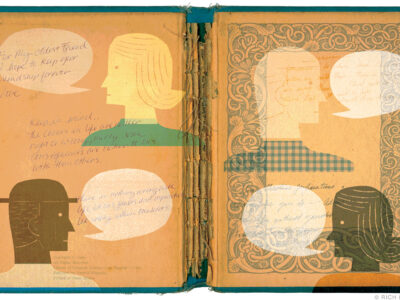
Class of ’91 & ’93 | When Delilah was born in February 2001, Oli Mittermaier C’93 G’93 and Elysa Marco C’91 had no idea what to do with this bouncing baby girl.
“All of a sudden we were confronted with having to buy all kinds of stuff—from car-seats to life-insurance policies,” says Mittermaier. “We kept stumbling into situations and wondering, ‘Where is all the information?’” Luckily he and Marco were part of a crack network of new parents in their hometown of San Francisco. They soon learned that the best crib, car-seat, and playground reviews came from people they already knew, and from moms and dads they’d meet (and eavesdrop on) around their neighborhood.
Mittermaier started writing it all down. He had some time on his hands. He’d just sold Careguide, the child- and elder-care management company he had started in 1995, and was taking care of his daughter while Marco, a medical resident, endured her own hectic schedule at the hospital. As he shared his notes with others, he noticed how happy they were to have someone else doing the legwork on the baby-friendly beat.
His entrepreneurial radar immediately tuned in to a black hole in the baby-product market. He asked a designer friend to conceive a cover, and he printed up 1,000 copies of the first guide. It was roughly based on the Zagat restaurant guides: Entries consisted of reviews straight from the mouths of local parents, and the book itself was that familiar tall, skinny trim. Coming up with the name, lilaguides, was easy. After all, (De)lila(h) had started this whole thing by being born without a blueprint. The first guide sold out in three months.
The lilaguides include opinions from every type of new mom and dad, be they hipster, preppy, laidback, neurotic, urban, or suburban. (The one thing they all have in common is a packed schedule.) Reviews are solicited by word-of-mouth and via Craig’s List, the online bulletin board, where Mittermaier posts weekly requests. No category makes it into a guide until a few thousand people have weighed in. Of course, there’s also the problem of information becoming outdated. (Around 30 percent of the guides’ entries change every 12 months.) By creating a computer program that processes, edits, and typesets reviews, Mittermaier has found a way to publish updated editions every year.
As the business grows, so do the number of “co-authors,” as Mittermaier calls the reviewers. In the beginning, the website (www.lilaguide.com) would receive a few hundred submissions per week. Now it’s typical to receive 6,000 in four days. Fourteen lilaguides are in print, plus two general guides, the Baby-Gear Buyer’s Guide and Bilingual Babycare. Twenty-five more are planned for September 2005. At that point, more than 100,000 will have been conceived.
Of course, Delilah continues to grow, too, as all of this activity goes on right under her nose. The Mittermaier/Marco home is the company’s headquarters. Marco helps out when she can, but her job as a clinical pediatric neurologist at the UCSF Medical Center keeps her pretty busy. So it was up to Mittermaier recently to set his daughter straight when she had an epiphany.
“She said to me, ‘Isn’t it funny that I was named after these books?’” Mittermaier recalls. “I had to sit her down and explain that the books were named after her.”
—Caroline Tiger C’96




